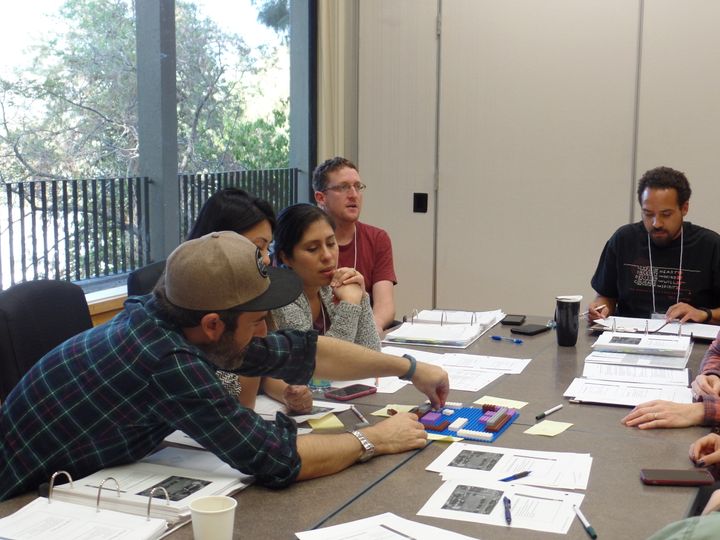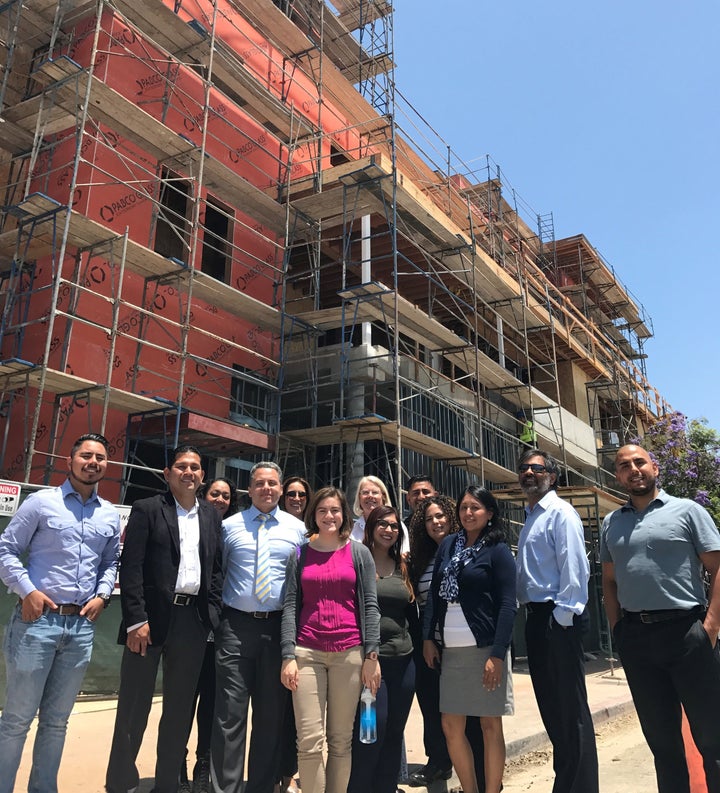By Kathleen Kelleher
For the people dedicated to closing California’s housing gap through the complex and highly-regulated world of affordable home development, there is no roadmap.
“We refer to regulations every day, all day long,” said Zohreh Khodabandelu, a project manager for Resources for Community Development, a Berkeley-based affordable housing developer that has built 2,200 homes in the Bay Area. “There is the financial part, rental market analysis, entitlement process, site feasibility, tax credits. Each project is comprised of many small pieces. We have to keep track of all of them.”
For most project managers, it’s a daunting task, and one that can take years to master. Which is why, nearly 30 years ago, the Local Initiatives Support Corporation launched the first Housing Development Training Institute (HDTI), a kind of boot camp for developers that lessens the learning curve for non-profit groups working to create and preserve affordable housing in California.
Since 1988, the program has graduated some 400 affordable housing developers who have gone on to help create nearly 30,000 quality homes for low-income residents. As the state’s affordable housing and homelessness crisis deepens, the need and demand for the kind of roadmap HDTI offers is more acute than ever.
“About 1.5 million Californians lack affordable housing.”
Last month, at a college campus in Pomona, Khodabandelu and 44 other project managers from all over California completed the two-week, comprehensive educational program, which delivers an in-depth, hands-on treatment of the low-income housing development process particular to California.
“This training helped me really understand the pieces for the first time,” Khodabandelu said. “Now, when one piece of a project is a challenge, I refer back to the training and apply what I learned.”

HDTI graduate Zohreh Khodabandelu is working on the renovation of Empyrean Towers, financed by LISC, in downtown Oakland, CA, with Resources for Community Development. Once renovated, the former dilapidated SRO will offer 65 affordable apartments in a fast-gentrifying neighborhood.
The cohort, the largest since HDTI’s 1988 launch, brought a special sense of urgency to the training. Participants are committed to housing the state’s poorest and most vulnerable residents and there’s no time to lose.
Indeed, California’s housing shortfall and homeless numbers top the nation. About 1.5 million of the state’s residents lack affordable housing, according to a California Housing Partnership Corporation (CHPC) report. Nearly half of the state’s existing affordable homes are at risk of conversion to market rate as finance and permit agreements expire. In 2016, the number of homeless people increased dramatically: in Los Angeles County, the figure increased by 23 percent, to nearly 58,000. In Alameda County, the number increased by a staggering 40 percent.
California has the highest percentage of people living in poverty nationwide, a population perilously at risk of housing loss when rents increase or jobs are lost. For one newly completed affordable housing complex in the San Francisco area, 98 apartments received more than 5,000 applicants to be put into a lottery for the units, leaving many on the waitlist. More than one in four renters pay at least half their income for rent and utilities, a number that has jumped 26 percent since 2007.
Voters have registered their distress over the housing and homelessness crises at the polls, passing two measures in Los Angeles that boost funding to affordable housing: Proposition HHH, a Los Angeles city bond measure will fund 10,000 new units of permanent housing for homeless over the next decade. Measure H, a county sales tax hike passed in March, sets aside $355 million in annual revenue for 10 years, and will help place 45,000 people in permanent housing over the next five years. Measure H funds are also slotted to prevent 30,000 more at-risk people from becoming homeless.

Non-profit developers hone their skills through simulation sessions, working with actual affordable housing case studies.
In the Bay Area, voters approved measures that will deliver local funds resulting in more than $2 billion in affordable housing to shelter the homeless, working families and first-time homebuyers.
Insuring that an experienced cadre of non-profit developers can make use of these resources, and create housing that will remain affordable for the long term, is HDTI’s goal.
“We need project managers for these affordable housing nonprofits to know how to use these and other funds,” said William Huang, a main HDTI trainer who is also director of the Housing and Career Services Department for the city of Pasadena and has been involved with several housing nonprofits in Los Angeles County. “So this training and capacity building is critical. We need to get the biggest bang for our buck and we want this money to be used efficiently.”
Affordable housing projects are financed with anywhere from three to a dozen different sources, said Laura Kobler, lead trainer with the California Housing Partnership and an HDTI alum. “They can take 4 to 5 years just to get all the financing together, and then some time to get the project approved and built.”
HDTI instruction covers various streams of finance, but also how to negotiate effectively among partners to keep projects moving forward, meeting deadlines, and staying on track. The program’s organizers estimate that this year’s cohort will contribute 17,186 more housing units to the bolster the state’s supply of low-income units.
“Graduates from this year’s training will contribute 17,186 more affordable housing units.”
For Cristina Martinez, an assistant project manager with Community Housing Works, a San Diego-based, nonprofit developer that has housed 8,000 people in 3,000 homes across the state, the beauty of the training is how it unpacks the nuts and bolts of housing development.
“It gave me an overview of tax credits, bonds, what terms we want for loans, why you would choose one contract over another,” said Martinez. “I had been doing things just to get things done, but I did not understand the reason why.”
HDTI students work on case studies during the course, culminating in simulations that use affordable housing experts who play the roles of city officials, lenders, and nonprofit leaders. Teams collaborated to “pencil out” their project within budget and regulatory restrictions, and then presented the feasibility of their cases to the whole group. The intensity of working in teams on a project forges enduring bonds.
For many participants, the experience of working numbers manually and analyzing the underpinning reasons for each step brought about a kind of clarity. “The training dives deeper into the logic behind the numbers,” said Leah Stockstrom, a project manager with the Tenderloin Neighborhood Development Corporation, a nonprofit affordable housing organization in San Francisco’s Tenderloin neighborhood that has built affordable apartments housing 4,100 people. “When you do it by hand [instead of with computerized spreadsheets], you have to slow down and add up the numbers.” Stockstrom also plans to put to use the knowledge she gained about solar tax credits for a new Tenderloin project.
Other training programs for affordable housing developers do exist, but they focus on single topics like financing, real estate or tax credits. HDTI is unique for being the most comprehensive. “What sets our training apart is we go through from conception to acquisition to construction to lease up, then all the elements of finance,” said Peggy Jen, senior program officer Bay Area LISC, who completed the training as a project manager 20 years ago. “There are 12-hour days, as inhumane as that sounds, and the small groups allow participants to work collaboratively, learn from each other and develop personal and professional bonds, all integral parts to a successful career in providing affordable housing in our communities.”
Like boot camp, HDTI instills a newfound confidence in the developers who undertake it. “I can now say I have the perspective to be able to resolve issues faster with lenders, city officials and investors,” said Peter Enzminger, project manager at Skid Row Housing Trust, a Los Angeles nonprofit providing permanent supportive homes for 1,800 people who have experienced homelessness. “We do permanent supportive housing exclusively and sometimes the people I deal with say ‘we don’t do it’ or ‘we don’t do it that way’ and I did not know how to respond. Now I know how to make people comfortable with what we are proposing.”

Cielito Lindo is an affordable housing community developed by East L.A. Community Corp. Antonio Ramon (pictured, in tie, with the real estate team), just completed the HDTI training that helped him manage the project.
“Each project is a snowflake,” said Antonio Ramon, who works for East Los Angeles Community Corporation, a nonprofit community developer that has built 550 homes and has 450 more in development in East Los Angeles. He was showing a visitor the Cielito Lindo Apartments in the Boyle Heights section of Los Angeles, a 50-unit affordable housing community. The first phase, a modern, multi-level design with ground floor retail space, a community room and rooftop garden, will be complete in October.
“I grew up in public housing in Chicago and everyone I grew up with had a Section 8 housing voucher,” said Ramon. “We had a roof over our heads, but it was not maintained properly. I can relate to the families and little kids I see move into our housing. I get a lot of gratification out of it.”
Kathleen Kelleher is a Santa Monica-based journalist who has written for the Los Angeles Times, the Orange County Register and Blueprint, among other publications.
